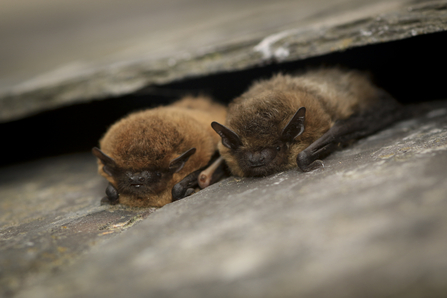An ancient solution to a common problem
The importance of ancient woodland cannot be overstated. This invaluable habitat holds significant importance to British wildlife, offering a complex and mature habitat that is a nod to a once wilder Britain. An ancient woodland takes hundreds of years to establish, providing the conditions for a rich assemblage of plants, animals and fungi to thrive. To be defined as such, a woodland must have existed continuously since 1600AD. Ancient woodlands are sanctuaries for Kent’s lesser-seen species, including one of our most fascinating and elusive animals: bats.
The UK boasts 18 species of bat, which represent around a quarter of all British mammal species. The IUCN Red List for Mammals lists 4 of our bat species as Threatened, 2 as Near Threatened and 3 as data deficient. British bats are threatened by habitat loss and fragmentation, loss of foraging resources, disturbance, and the destruction of roosts. The mismanagement of woodland also poses a significant threat to bat populations, and the widescale loss of 70% of ancient woodland in the UK only serves to worsen their fate. In order to protect bats, we must protect ancient woodland.
Ancient woodlands are a bat buffet
Bats are skilled, acrobatic hunters and have evolved an efficient method of locating prey. Despite popular belief, bats are not blind. Using echolocation as their main tool for catching food, bats are able to make up for their limited vision through sound. Woodland edges are used as navigational landmarks, guiding bats to and from their roosts. Despite weighing no more than a one pound coin, the common pipistrelle - Kent’s most common species of bat - can consume a whopping 3,000 insects in a single night on the wing.
Bats rely on diverse insect populations for food, but due to changes in pesticide use and habitat degradation, native insect populations have drastically declined since the Industrial Revolution. A decrease in hedgerows, wildflower meadows and waterbodies and an intensive increase of pesticides has led to a nationwide decline in invertebrates, placing a significant pressure on bat populations.
Ancient woodlands are biodiversity hotspots. They support a wide variety of insects, including many specialist species that are rarely found elsewhere. They provide a varied range of micro-habitats, including ancient trees, dead and decaying wood, dense vegetation, leaf litter and open clearings. This mosaic of micro-habitats creates opportunities for fauna and flora big and small to exploit every nook and cranny of the woodland.
Oak trees alone support over 2,000 species in the UK, roughly 300 of which rely solely on the tree for survival. A single oak tree can provide a food source for bats for decades and even centuries at a time. Mature trees also create an ongoing supply of valuable decaying wood. Approximately 800 species of beetle - a favourite prey item of many bat species - rely on deadwood to complete their lifecycle. Ancient woodlands also support a whole host of woodland wildflowers and food plants that attract all important pollinators. From miniscule beetles and buzzing bees to beautiful butterflies and micro moths, ancient woodlands provide a rich community of insects to bats, birds, reptiles and amphibians.

